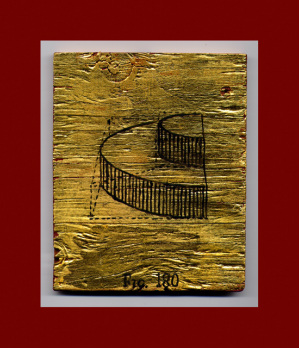24k.
Matt Harley
February 10-28, 2012

24 kt. (a philosophical proposition)
Pure, 24-carat gold surrounds itself with a permanent electrostatic field at just the right frequency to annihilate all bacteria that come within its boundaries (leaving a corona of untouched culture around golden objects placed in the centre of infected Petri dishes). Among the metals, gold has the rare ability to resist oxidization, making it impervious to corrosion and discoloration under normal atmospheric conditions. Because of its seeming incorruptibility, the earliest civilizations, oceans apart, independently followed the cultural pattern of ascribing a spiritual value to gold, followed by a commercial value some hundreds of years later. In one period in medieval Japan gold was restricted to objects and decorations exclusively for the Emperor (descended from the spiritual founder of Shinto), or the interior of the Emperor’s palace, as well as discreet decorations on the sword guards of certain Samurai warriors (ultimately servants of the Emperor). Similar restrictions are seen in cultures during various periods, again across continents.
Beyond the obvious – avarice and murder – gold has an even darker side. The chemical process for extracting gold now in use, as opposed to the ancient (slower) smelting methods, leaves behind arsenic trioxide, one of the deadliest agents known to mankind. A couple of milligrams shuts down the nervous system within seconds.
Now that “advanced art” is a branch of philosophy, the role of the would-be “advanced” artist becomes that of artist/philosopher. Naturally, nothing less than brilliance is the aspirant’s goal. The thought of merely illustrating existing philosophical propositions leads inevitably to the question of how to include the intuitive and unexplainable quality inhabiting the most sublime artworks, where form and feeling exist in total integration, achieving a perfect balance of object and concept, making possible the communication of philosophical understanding without the necessity of linguistic explanation.
Given the non-linear nature of such a goal, every decision regarding every detail of a given artwork now includes not only its aesthetic implications (and potentialities) but also its intellectual, ethical, moral, poetic, and spiritual implications, plus, most difficult to achieve, its emotional implications – the ‘je ne sais quoi’ behind the phenomenon of near-universal agreement on which the greatest masterpieces from all cultures and periods are. To facilitate thinking about absolutely every detail, including the ineffable, the now-beleaguered artist begins researching all of the above plus related fields of study the better to make the most informed, possible decisions. These extend from the form the artwork takes in the physical world to its less tangible aspects such as the title or the list of materials - especially the list of materials.
Consider the poetry of this: ink, watercolor, 24-carat gold leaf, toilet-paper tube.
-Matt Harley, New Year’s Day, Year of the Dragon, 23rd January, 2012
The exhibition, 24 kt., was comprised primarily of paintings in watercolor, gouache, enamel, & 24-carat gold on construction-grade plywood.